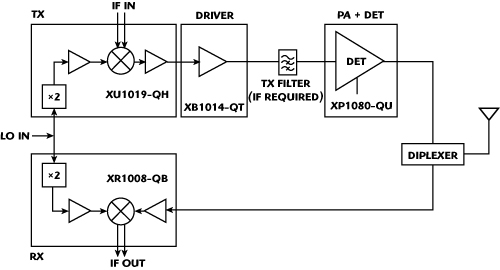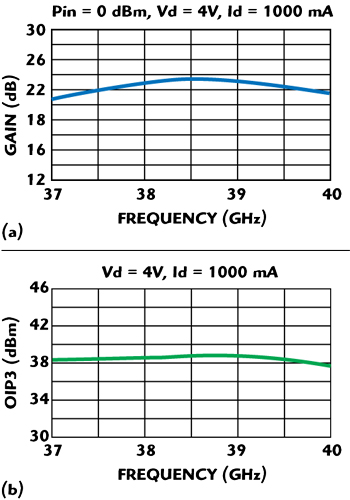Sustained growth in wireless communications and greater demands for bandwidth place tremendous pressure on component manufacturers to provide high performance, surface-mount technology (SMT) packaged products. The market is seeking low-cost, SMT components for high volume printed circuit board (PCB) assembly flow, particularly for applications such as point-to-point (PTP) digital radio at microwave and millimeter-wave frequencies. The drivers for industry growth in the PTP market are next generation data services and the rapid expansion of cellular usage in developing nations such as China and India. In order to meet the performance, cost and time to market requirements of these systems, OEMs are turning to complete SMT chipset solutions.
Mimix Broadband’s new 38 GHz Mimix SmartSet products are high performance, highly integrated devices that are offered in SMT packages and include a receiver, up-converter, driver amplifier and power amplifier. The Mimix SmartSets offer industry leading performance and are consistent with typical requirements for high performance PTP ETSI 38 GHz Radios. The SMT packages offer a number of advantages, including low cost, ease of handling and assembly, and suitability for mass production.

Figure 1 Mimix SmartSet: 38 GHz transceiver.
Figure 1 shows the functional schematic for a transceiver using the 38 GHz Mimix SmartSet. On the transmit (TX) side, the IF1 and IF2 inputs are applied through a 90 degree hybrid for image rejection. The XU1019-QH up-converter is balanced, so the complimentary outputs IF1* and IF2* are also brought out, and normally terminated to 50 ohms. The 2×LO leakage can be minimized by tuning the DC bias on the main and complimentary IF signals. If further 2×LO rejection is required, the signal is filtered after the output of the transmitter through a bandpass filter (BPF). Gain is provided by the linear driver amplifier XB1014-QT, and the power amplification and detector functions are implemented in the XP1080-QU. Linear gain control of the Tx lineup can be achieved through drain current control of the XU1019-QH, XB1014-QT and XP1080-QU. The received signal is coupled into the XR1008-QB receiver, which integrates a low noise amplifier and image reject mixer.
XR1008-QB Packaged 38 GHz Receiver
A receiver chain is traditionally designed using up to four MMICs: an LNA that provides the optimum noise figure; an image reject mixer with high linearity performance; an LO driver amplifier; and often, a frequency doubler for the LO input. In this device, all of these functions are combined into a single SMT chip.

Figure 2 Conversion gain (a), image rejection (b) and noise figure (c) of the XR1008-QB.
The XR1008-QB offers 12 dB conversion gain, 20 dB image rejection and 4 dB noise figure (see Figure 2). The device is offered in a 7 × 7 mm surface-mount package that can be installed onto radio boards using standard SMT manufacturing lines.
XB1014-QT Packaged 38 GHz Linear Driver Amplifier
This small, low cost, three-stage 37 to 40 GHz GaAs MMIC driver amplifier has a small-signal gain of 21 dB with an OIP3 of 30.5 dBm. The device delivers 22 dBm of saturated power, and P1dB of 19.5 dBm.

Figure 3 Small-signal gain (a) and OIP3 (b) of the XB1014-QT.
Typical 38 GHz Tx paths require some level of ATPC, and the XB1014-QT gain turn-down while maintaining linear performance is easily achieved by control of the drain currents. The device is offered in a low cost 3 × 3 mm plastic QFN package. Typical gain and OIP3 performance curves are shown in Figure 3.
XP1080-QU Packaged 38 GHz Linear Power Amplifier
Mimix Broadband’s four-stage 37 to 40 GHz GaAs MMIC power amplifier has a small-signal gain of 22 dB with an OIP3 of 38 dBm. An on-chip temperature compensated power detector has a useable dynamic range of greater than 25 dB.

Figure 4 Small-signal gain (a) and OIP3 (b) of the XP1080-QU.
This device is a highly compact, low-cost amplifier ideally suited for the digital microwave radio market. The amplifier comes in a 7 × 7 mm QFN-style package, giving the user an easy-to-install 38 GHz power amplifier product with excellent linear performance. Typical gain and OIP3 performance curves are shown in Figure 4.
XU1019-QH Packaged 38 GHz Up-converter
Mimix Broadband’s 38 GHz up-converter integrates a mixer, RF buffer, LO buffers and LO doubler. The balanced mixer uses an image rejection configuration, offering good nominal 2 × LO leakage into the RF port. This performance can be enhanced by applying appropriate DC bias to the four IF lines coming out of the package (IF1, IF1*, IF2, IF2*). The bias is applied through simple bias tees in line with the IF ports and can be tuned to various levels of complexity (over frequency, over temperature), depending on the level of 2 × LO leakage the user has allowed. The addition of image rejection in the up-converter results in minimal or no Tx filtering required, depending on power detector accuracy requirements.

Figure 5 USB conversion gain (a), image rejection (b) and 2×LO isolation (c) of the XU1019-QH.
The up-converter achieves 7 to 9 dB gain across the 38 GHz band, 20 dBc image rejection and tuned RF 2 × LO isolation of greater than 17 dB, as shown in Figure 5. The device comes in a 4 × 4 mm QFN package.
“Mimix SmartSet Solutions”
The concept of Mimix SmartSet Solutions has been applied not only to 38 GHz, but to all the major PTP bands, providing the industry with highly integrated devices that are offered in SMT packages and include a receiver, up-converter, driver amplifier and power amplifier. The SMT packages offer a number of advantages, including low cost, ease of handling and assembly, and suitability for mass production.
Mimix Broadband Inc.
Houston, TX
(281) 988-4600
www.mimixbroadband.com
RS No. 303
